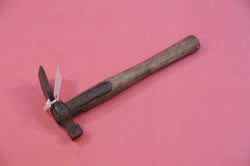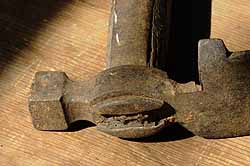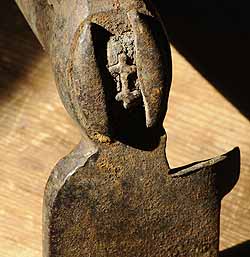
The Scottish Mountain Heritage Collection
Objects Database
Slater's hammer
Accession Number
800.2009.1
Object Name
Slater's hammer
Created
29/01/2009
Creator
Hermione Cooper
Accession Date
29/01/2009
Brief Description
A slater's modified hammer with square hammer head and square adze. Wooden shaft.
Materials
wood, metal
Dimensions
Shaft 33(l) x 10(cir)cms. Head 16(l) cms.
Number Of Objects
1
Colour
brown
Provenance
It maybe hard to believe in the modern high tech world, that folk were using slater's hammers to climb ice back in the 1930's and 40's , but they were. Step cutting with wooden shafted axes was the norm in those days as front points on crampons were yet to be invented and most climbers still used nailed boots rather than crampons. Anything that could gain more security was quickly embraced as more and more difficult climbs were tackled.
In 1938 F. Gardner Stangle, Dick Morsley and Percy Small did the first ascent of Comb Gully on Ben Nevis. Stangle found the short length of his modified Slater's hammer invaluable on the steep ice and used the pick of this tool on all of the ice pitches.
An early pioneer, Douglas Scott, had a short axe made by a Cambuslang blacksmith in 1936(we have it in our collection) and seeing how effective it was, his pal W.H.(Bill) Murray went off to the local ironmongers and bought a slater's hammer, removed the side claw and put it to good use on many a Scottish Gully.
The hammer we have here in the collection was found on Ben Nevis in the 1980's which would indicate that it had been used for climbing; what and by whom we don't know unfortunately - if only it could talk!
Acquisition Date
29/01/2009
Condition Check Date
28/04/2009
Normal Location
Bohuntin
Current Location
Bohuntin
Rules
Spectrum : UK Museum documentation standard, V.3.1 2007
Modified
28/04/2009




